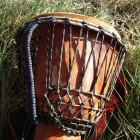Rhythm Culture: Where We Begin
Struck sound gives pleasure, whereas unstruck sound leads to liberation.
–the Narada Purana
Rhythm is everywhere. All of Nature, whether the natural rhythms familiar to us on our whirling Earth, or the deepest and most distant cosmic impulses, breathes with a regularity as identifiable as our own heartbeat. To drum is to connect more fully with this universal pulse, leaving the rest of our temporary divisions behind.
At the same time, to give ourselves to the power of the drum is not merely to dissolve into the cosmic soup. The power of rhythm is both unifying and freeing. There is room for infinite creativity, made possible by the strength of the deep foundation. The common pulse gives us permission to partake of a dynamic dance that celebrates the richness of diversity within wholeness.
The African homeland of the human race has been from time immemorial a living rhythm workshop. It is here that we can find the oldest and richest musical tradition on the planet. In particular, the countries of West Africa, from Senegal and Mali down through Nigeria and the Congo, provide us to this day with a sophisticated and powerful body of rhythms that can fuel the dancing spirit like no other.
The present collection also pays special homage to the New World lineage, the rhythmic legacy brought by slaves and kept alive through centuries of unimaginable suffering. The Afro-Latin tradition blends the musical and cultural roots of Africa with non-African elements in a vibrant and life-affirming style that has universal appeal. In addition, the body of rhythms known as “Middle Eastern” is represented with a small selection; here African roots are blended with wider Mediterranean and Arabian influences.
This now-widespread body of African-based rhythms comes to us from a variety of historical and cultural contexts that still hold specific and sacred meanings for the people living within those settings. Outsiders (like myself) can only give respect for the gift of this music which has gone out from the regions of its birth and development. And while our intentions cannot be identical to those of the originators of this music, we can yet commit ourselves to the sacred power of its instruments and rhythms which we have received, and to give our own best energy to its continuing evolution.
One of music’s greatest gifts is its age-old ability to flow across cultural boundaries, fostering both unity and healthy diversity, appreciation and understanding. Let us honor the traditions reflected here as contemporary vehicles for human freedom, as living channels of greater connection with nature and spirit.
The present collection begins with an introduction to Rhythm Notation, time signatures, and hand drum technique, followed by a more in-depth exploration of the foundations of polyrhythmic percussion. The main body of the book consists of Collected Rhythms for ensemble, from the African, Afro-Latin, and Middle Eastern traditions. Chapter 4 is a virtual Rhythm Workshop, which distills from the actual rhythms an essential toolkit for drummers, with a wide variety of generic and standard patterns and exercises. Chapter 5 takes us beyond the rhythms to the qualitative side of Rhythm Culture: Where We Go with this music. Finally, a selected list of Resources and references (with online links) serves as a guide for further enjoyment and study.
Why Notation?
Written notation is not part of the ancient African musical tradition. To learn a traditional African rhythm in the traditional way, means to grow up in the culture where the music is a living part of you, or to study for years with a master drummer (or both).
Written notation–like writing itself–is a tool that newcomers to the tradition can use to access and learn the music more quickly. Audio recording is another useful tool. Both are simply aids to memory in recalling a rhythm you may have heard or learned only once. Notation can also aid learning and communication between drummers, whether or not you’re in the same room.
“The map is not the territory”…but having a map to follow is better than being lost–or not going on the journey at all.
![]()
overview of Roots Jam 2 ![]() more sample pages
more sample pages
Order now:
